

Haecceitas. In der Scholastik wurde zunächst von Thomas von Aquin mit Aristoteles das Individuelle als Spezialfall des Allgemeinen angesehen.
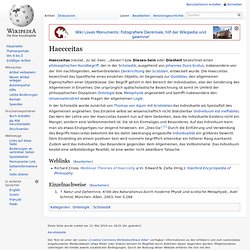
Das Einzelne selbst sei wissenschaftlich nicht diskutierbar (Individuum est ineffabile). Der Kern der Lehre von der Haecceitas basiert nun auf dem Gedanken, dass die individuelle Existenz nicht ein Mangel, sondern eine Vollkommenheit ist. Sie ist ein Einmaliges und Besonderes. Auf das Individuum kann man als etwas Einzigartiges nur zeigend hinweisen: ein „Dies-Da“.[1] Durch die Einführung und Verwendung des Begriffs Haecceitas bekommt die bis dahin zweitrangig eingestufte Individualität ein größeres Gewicht.
Dem Einzelding als einem positiven Sein wird nunmehr begrifflich erkennbar ein höherer Rang zuerkannt. Weblinks[Bearbeiten] Richard Cross: Medieval Theories of Haecceity. Einzelnachweise[Bearbeiten] Hochspringen ↑ Natur und Geheimnis: Kritik des Naturalismus durch moderne Physik und scotische Metaphysik., Axel Schmid, München: Alber, 2003, hier S.268. Haecceity. Haecceity (/hɛkˈsiːɪtɪ/; from the Latin haecceitas, which translates as "thisness") is a term from medieval philosophy first coined by Duns Scotus which denotes the discrete qualities, properties or characteristics of a thing which make it a particular thing.
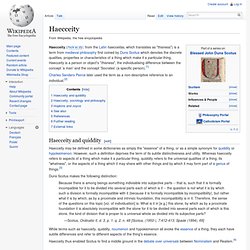
Haecceity is a person or object's "thisness", the individualising difference between the concept 'a man' and the concept 'Socrates' (a specific person).[1] Charles Sanders Peirce later used the term as a non-descriptive reference to an individual.[2] Medieval Theories of Haecceity. 1.

Individuation and the identity of indiscernibles The possible existence of such non-qualitative properties as explanations of numerical distinction between substances can be made plausible by considering a famous counterexample to the identity of indiscernibles suggested by Max Black. A wants to defend the principle, and B attack it, and B does so by proposing the following case: Isn't it logically possible that the universe should have contained nothing but two exactly similar spheres?
We might suppose that each was made of chemically pure iron, had a diameter of one mile, that they had the same temperature, colour, and so on, and that nothing else existed. Clearly, if Leibniz's Law is understood — as Leibniz intended — to assert that any two individuals must differ in some qualitative or relational way, B's counterexample seems sufficient to refute it. Theories of haecceities may want to assign more or less ontological weight to haecceities, and, indeed, to properties in general. Quidditas.
Quidditas, auch quiditas („Washeit“, eingedeutscht Quiddität oder Quidität) ist ein lateinischer Begriff, der aus der Fachsprache der mittelalterlichen Philosophie stammt.
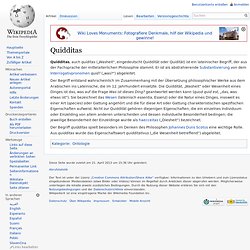
Er ist als abstrahierende Substantivierung von dem Interrogativpronomen quid? („was? “) abgeleitet. Der Begriff quidditas spielt besonders im Denken des Philosophen Johannes Duns Scotus eine wichtige Rolle. Quiddity. In scholastic philosophy, quiddity (/ˈkwɪdɪti/; Latin: quidditas)[1] was another term for the essence of an object, literally its "whatness," or "what it is.
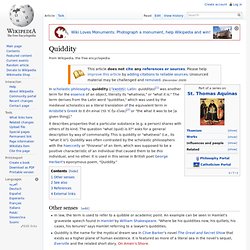
" The term derives from the Latin word "quidditas," which was used by the medieval scholastics as a literal translation of the equivalent term in Aristotle's Greek to ti ên einai (τὸ τί ἦν εἶναι)[2] or "the what it was to be [a given thing]. " Hypokeimenon. Hypokeimenon (Greek: ὑποκείμενον), later often material substratum, is a term in metaphysics which literally means the "underlying thing" (Latin subiectum).

To search for the hypokeimenon is to search for that substance which persists in a thing going through change— its basic essence. The existence of a material substratum was posited by John Locke, with conceptual similarities to Baruch Spinoza's substance and Immanuel Kant's concept of the noumenon (in The Critique of Pure Reason). Locke theorised that when all sensible properties were abstracted away from an object, such as its colour, weight, density or taste, there would still be something left to which the properties had adhered— something which allowed the object to exist independently of the sensible properties that it manifested in the beholder. Locke saw this ontological ingredient as necessary if we are to be able to consider objects as existing independently of our own minds. Hypokeimenon. Ousia. Philosophical and scientific use[edit] Theological significance[edit] New Testament[edit] The word ousia is not used in the New Testament except in relation to the substance in the sense of goods twice in the parable of the Prodigal Son where the son asked his father to divide to him his inheritance, and then wasted it on riotous living.[4][5] Early Christianity[edit] It must be regarded as certain that the council, which condemned Paul, rejected the term homoousios; but, naturally, only in a false sense, used by Paul; not, it seems, because he meant by it a unity of Hypostasis in the Trinity (so St.
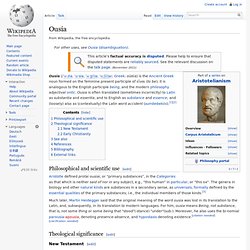
The generally agreed-upon meaning of ousia in Eastern Christianity is "all that subsists by itself and which has not its being in another"[7] - in contrast to hypostasis, which is used to mean "reality" or "existence".[8] See also[edit] References[edit] Bibliography[edit] Leo Donald Davis, The First Seven Ecumenical Councils (325-787): Their History and Theology, Liturgical Press, 1983. Subjekt (Philosophie)